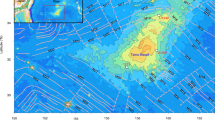Abstract
A morphotectonic depression, some 15 × 106 km2 in area and centred on the Australia–Antarctic discordance1, extends across the southern half of Australia through the south-east Indian Ocean to Wilkes Land in Antarctica (Fig. 1a, b). The depression is co-extensive with a negative satellite free-air gravity anomaly2 which suggests that the region is underlain by downward convecting asthenosphere. Here I outline the depression and explore its age. In a pre-breakup (>55 Myr) reconstruction (Fig. 1c), the Eastern Highlands of Australia and the Transantarctic Mountains are colinear; because the Eastern Highlands were notably high during the late Cretaceous, and shared with the Transantarctic Mountains a history of volcanism in the Jurassic, both highlands probably constituted the eastern flank of the past depression, in the centre of which thick (>8 km) late Cretaceous sediment in the Ceduna Saddle3, and a possible mirror-image in offshore Antarctica, mark its depocentre. A broad area of late Carboniferous marine sediments in southern Australia4 may represent the earliest sign of the depression.
This is a preview of subscription content, access via your institution
Access options
Subscribe to this journal
Receive 51 print issues and online access
$199.00 per year
only $3.90 per issue
Buy this article
- Purchase on Springer Link
- Instant access to full article PDF
Prices may be subject to local taxes which are calculated during checkout
Similar content being viewed by others
References
Weissel, J. K. & Hayes, D. E. J. geophys. Res. 79, 2579–2587 (1974).
Anderson, R. N., McKenzie, D. & Sclater, J. G. Earth planet. Sci. Lett. 18, 391–407 (1973).
Veevers, J. J. J. Geol. 89, 57–82 (1981).
Veevers, J. J. & Evans, P. R. in Gondwana Geology (ed. Campbell, K. S. W.) 579–607 (ANU, Canberra, 1975).
Veevers, J. J. Earth planet. Sci. Lett. 34, 100–106 (1977).
Drewry, D. J. J. geol. Soc. Lond. 131, 255–273 (1975).
Brotchie, J. F. & Silvester, R. J. geophys. Res. 74, 5240–5252 (1969).
Jones, J. G. & Veevers, J. J. J. geol. Soc. Aust. (in the press).
Morley, M. E., Gleadow, A. J. W. & Lovering, J. F. in Gondwana Five (eds Cresswell, M. M. & Vella, P. ) 289–293 (Balkema, Rotterdam, 1981).
Embleton, B. J. J. & Schmidt, P. J. geophys. Res. 86, 3998–4008 (1981).
Johnstone, M. H., Lowry, D. C. & Quilty, P. G. J. R. Soc. W. Aust. 96, 5–15 (1973).
Fraser, A. R. & Tilbury, L. A. Aust. Petrol. Explor. Ass. J. 19, 53–65 (1979).
Wopfner, H. Trans. R. Soc. S. Aust. 86, 247–253 (1963).
Williams, G. E. & Goode, A. D. T. Search 9, 442–447 (1978).
Stump, E., Sheridan, M. F., Borg, S. G. & Sutter, J. F. Science 207, 757–759 (1980).
Domack, E. W., Fairchild, W. W. & Anderson, J. B. Nature 287, 625–626 (1980).
Houtz, R. E. & Markl, R. G. Am. geophys. Un. Antarctic Res. Ser. 19, 147–164 (1972).
Drewry, D. J. Tectonophysics 36, 301–314 (1976).
McGowran, B. Science 180, 759–761 (1973).
Wopfner, H. in Gondwana Five (eds Cresswell, M. M. & Vella, P.) 185–190 (Balkema, Rotterdam, 1981).
Wellman, P. BMR J. Geol. Geophys. 4, 373–382 (1979).
Bathymetric Chart of Antarctica (in Russian) (Main Administration of Geodesy and Cartography, Moscow, 1974).
General Bathymetric Chart of the Oceans (GEBCO) 5.18 (Canad. Hydro. Serv., Ottawa, 1980).
Drewry, D. J. Pol. Rec. 17, 359–374 (1975).
Masolov, V. N., Kurinin, R. G. & Grikurov, G. E. in Gondwana Five (eds Cresswell, M. M. & Vella, P.) 303–309 (Balkema, Rotterdam, 1981).
Richards, K. A. & Hopkins, B. M. ECAFE Natural Resources Symp. (Canberra, 1969).
Kyle, P. R., Elliot, D. H. & Sutter, J. F. in Gondwana Five (eds Cresswell, M. M. & Vella, P.) 283–287 (Balkema, Rotterdam, 1981).
Dulhunty, J. A. J. R. Soc. N.S. W. 105, 71–76 (1972).
McDougall, I. & Wellman, P. J. geol. Soc. Aust. 23, 1–9 (1976).
Schmidt, P. W. & McDougall, I. J. geol. Soc. Aust. 25, 321–328 (1977).
Griffiths, J. R. Nature 249, 336–337 (1974).
Weissel, J. K., Hayes, D. E. & Herron, E. M. Mar. Geol. 25, 231–277 (1977).
Author information
Authors and Affiliations
Rights and permissions
About this article
Cite this article
Veevers, J. Australian–Antarctic depression from the mid-ocean ridge to adjacent continents. Nature 295, 315–317 (1982). https://doi.org/10.1038/295315a0
Received:
Accepted:
Issue Date:
DOI: https://doi.org/10.1038/295315a0
This article is cited by
-
Morphology and tectonics of the Australian-Antarctic Discordance between 123� E and 128� E
Marine Geophysical Researches (1993)
-
Isotope evidence of a mantle convection boundary at the Australian-Antarctic Discordance
Nature (1988)
Comments
By submitting a comment you agree to abide by our Terms and Community Guidelines. If you find something abusive or that does not comply with our terms or guidelines please flag it as inappropriate.



